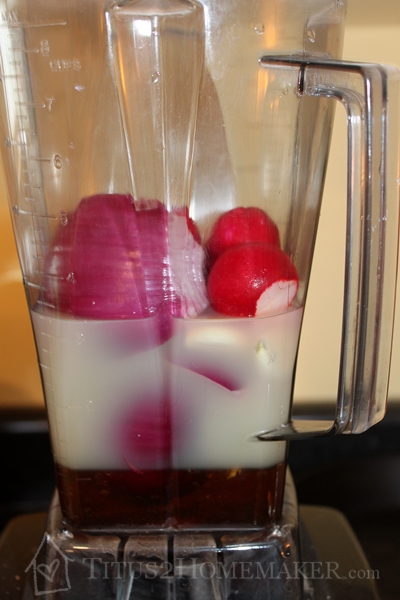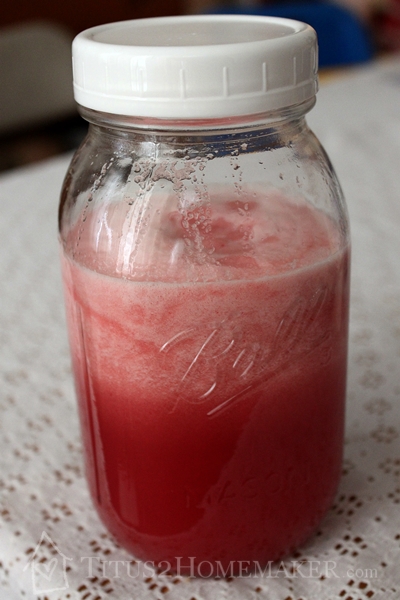I search and try all kinds of over the counter meds and herbal remedies and here is another one I feel is worth trying.
It has been a long weekend at our house. Our littlest came down with the flu (or some flu-like virus, anyway) – not such a big deal, except that she had a febrile seizure and stopped breathing, resulting in a 911 call and many hours at doctors’ offices/the ER. Then the eldest and hubby both came down with it. (Little one is doing much better now, by the way. And by “better,” I don’t just mean that she’s breathing. We’re back to normal temps, etc. and just a few residual sniffles.)
Anyway, this was a great opportunity for me to take some pictures of the decongestant I’ve posted here before, and include an actual tutorial. Hubby calls this “radish juice.” It sounds like it would be disgusting, but it’s actually not nearly as bad as it sounds. (I don’t like radishes or onions, in general, and I find this tolerable, ‘though it’s definitely not a favorite. Hubby actually kind of likes it – especially if his nose is also stuffy so he can’t smell the onion as strongly.) As long as they’re old enough to safely have honey, even the little ones can take this. (And I was surprised. Our almost-two-year-old, who has been protesting the cherry-flavored Tylenol, drank this voluntarily, and even got mad at me when I took it away out of concern that too much at once might burn her tummy. She did make some pretty funny faces, though.) The recipe came from a friend, and is good for breaking up the junk in your chest. Keep reading below the recipe for a full step-by-step.
Homemade Decongestant
Author: Annette McEndarfer

This homemade decongestant is good for breaking up chest congestion so you can clear it out. Anyone old enough to eat honey can take it.
Ingredients
- 1 c. honey
- 1 c. lemon juice
- 5-7 radishes
- 1 sm. red onion
- 6 garlic cloves (If my cloves are super-small, I use a couple more.)

Instructions
- Wash, peel, and trim the vegetables as appropriate, and cut the onion into 2-4 chunks.
- Dump everything into the blender and blend until smooth.
- Strain.
- Refrigerate between uses, for up to a week or so.
- TO USE:
- Adults take 2 Tbsp. once a day, or more as needed/desired.
- Children take 1 Tbsp. once a day, or more as needed/desired.
- Should begin expelling within 24 hours. (We have typically noticed it kicking in within the first couple hours.)
Assemble the Ingredients
honey
lemon juice
garlic
red onion
radishes
lemon juice
garlic
red onion
radishes
The original recipe calls for freshly-squeezed lemon juice. This would probably be rather higher in vitamin C, which would be beneficial, but lemons are always super-expensive around here during flu season. And this time, I literally couldn’t find any at the grocery store. So I just use the jarred stuff (make sure it’s regular strength, rather than concentrated), and it works just fine.
Put Everything in the Blender
If you have a Vitamix or a good blender, you shouldn’t have to do a lot of prep. Wash the radishes, peel the garlic and onion, and cut off top and bottom edges. You might also want to cut the onion into 2-4 chunks. But you shouldn’t have to mince anything, etc.
Because the Vitamix container has measurements on it, I just use that for measuring the liquids, too. I pour in lemon juice to the 1-cup line, then pour in honey ’til it all reaches the 2-cup line, then toss in the veggies.
Blend It
Put the lid on (of course!) and blend everything up ’til it’s smooth. As you can see, it doesn’t lookunappetizing at all. In fact, it rather looks like a strawberry-heavy fruit smoothie. (You could have some real fun with someone who can’t smell well! lol)
Strain It
Unfortunately, I don’t have any pictures of this step, as I can’t hold my strainer and pour and take a picture at the same time. I pour it through a wire mesh strainer (like you’d use for straining herbal teas) into a quart jar, a little at a time. I have to stir it a bit with a spoon to get the pulpy part out of the way and let the liquid part run through. As I decide that each strainerful is done, I scoop the pulp out into a separate bowl, to get it out of the way. (If your strainer is large, you might be able to pour it in all at once, but mine is about as big around as a cup.)
That’s It!
It’s done. Cap it and store it in the refrigerator when you’re not using it. I don’t know for certain how long it will “officially” keep in the fridge, but I wouldn’t keep it longer than about a week or so. As you can see, I still had some variation in the thickness/viscosity, even after straining it, so we shake it up before taking it. There’s a picture below you can print out if you want to use it as a label.
Notes
In case anyone asks…
- I have wondered, myself, if this can be frozen and used later, or if it will completely lose its efficacy. (We rarely have these ingredients all on hand when everyone gets sick, so it would be nice to not have to head to the store.) I am planning to freeze the leftovers this time, though, and I will update if I ever figure that out! (In the meantime, if any of you try it, please let us know how it goes.)
- What about the pulp? In the past, I’ve just thrown it out, but that seems wasteful. I’m thinking, given the ingredients, that one could probably use it in soups, in small amounts, so I froze the pulp in an ice cube tray. We’ll see how that goes.
- Is it okay for pregnant/nursing mamas? I don’t see why not. I’m pregnant, myself, and I’m pretty particular about what I’ll put into my body when I’m expecting, but I would definitely take this if I came down with what my family has. All of the ingredients are things I eat as food, so I don’t think any of it will be unsafe. The only downside I can see for nursing mothers is that the garlic and onion are pretty strong and some babies might not like the taste of the milk after mama takes it. I don’t think it would be harmful, though. This is just my educated opinion, though, and shouldn’t be considered medical advice. Do your own due diligence.

- What about babies? Honey should not be given to babies under a year old, due to the rare but serious possibility of infant botulism. I would guess that if you make it without the honey, you could add about 3 parts of the mixture to about 1 part of glycerin or sugar syrup or something and give it to a baby in small amounts. Again, though, this is not medical advice, just the educated opinion of one mom. Use your own judgment. (If you have a baby that young with respiratory issues, I hope you’re talking to someone with medical experience, anyway, and can seek their opinion.)
- Where did I get that lid? I love these one-piece lids for storage; they’re so much less of a pain than 2-part canning lids. You can get metal ones in the regular size, I think (but I haven’t found the wide-mouth size), but the plastic ones are easier to find and work just fine.






No comments:
Post a Comment